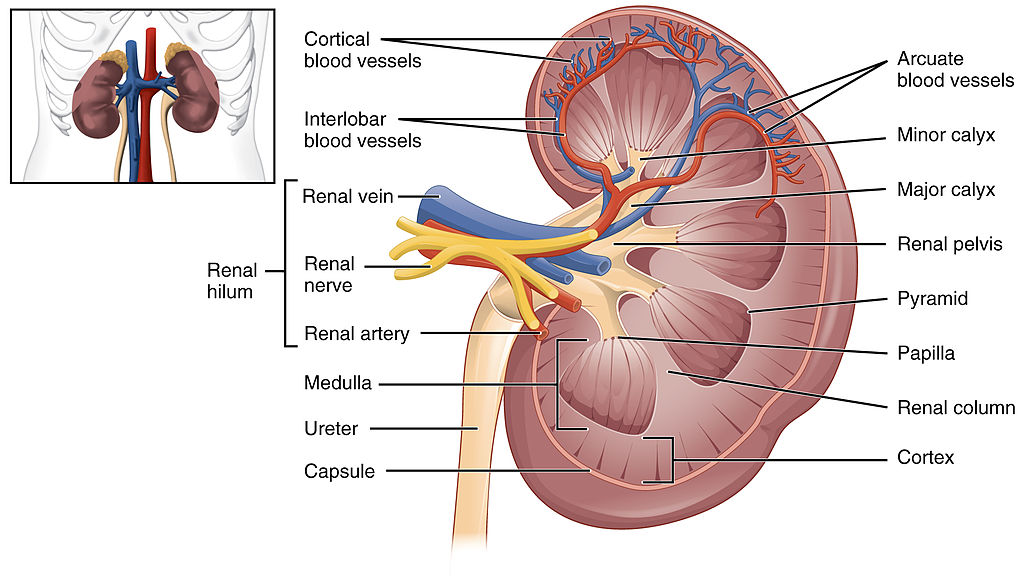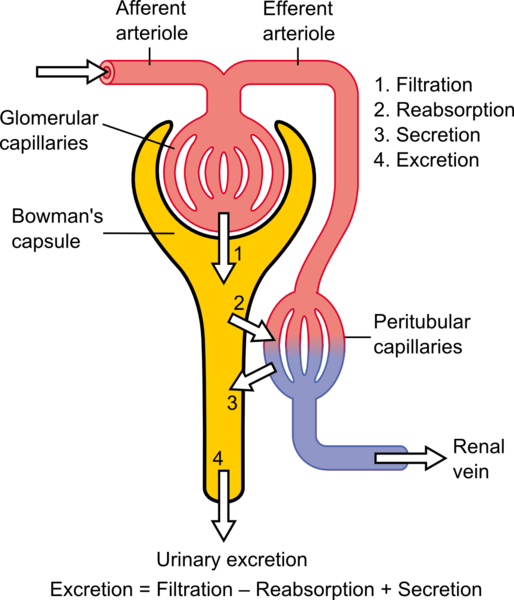Urine-Formation Process (Biological Sciences)
Good evening team #steemstem. Today I want to share my article "Urinary Formation", as we know that urine is one of the biological things that exist to us living beings, human or animal. But I will discuss the process of forming urine in humans.
The process of formation of urine consists of 3 stages, the first is; Filtration, Reabsorption and Augmentation. Yes three stages, The third stage occurs in the kidney. Here is a brief discussion.
Kidney

CC BY 3.0
Kidneys are excretory organs in vertebrates that are shaped like beans. As part of the urinary system, the kidneys function to filter out dirt (especially urea) from the blood and dispose of it along with water in the form of urine. A branch of medicine studying the kidneys and the disease is called nephrology.
Nephrons are the smallest unit of the kidney that serves to filter the blood and retrieve useful substances into the blood.
Nefron itself consists of 3 parts, namely proximal tubular kontratus, distal contrast tubules and koligentes ducts.
Process Urine Formation
1. Filtration
- Filtration is a blood-filtering process that contains harmful substances of metabolic waste. The substance is toxic to the body.
- Filtration occurs in the malpighi body consisting of glomerulus and bowman capsule
- Glomerulus serves to filter water, salt, amino acids, glucose, and urea.
- The filtration result in the glomerulus will flow into the bowman capsule and produce the primary urine.
- Primary urine contains water, sugars, amino acids, salts / inorganic ions and urea.
2. Reabsorption
- Reabsorption occurs in the proximal con- tract tubules and produces secondary urine.
- The primary urine collected in Bowman's cotton into the proximal contral tubule and reabsorption occurs.
- In this process occurs the process of re-absorption of substances that are still useful to the body by the wall tubulus, then into the blood vessels that surround tubules.
- Substances reabsorbed by the blood include: glucose, amino acids, and inorganic ions (Na +, Ka +, Ca2 +, Cl-, HCO3-, HPO43- and SO43-)
- Secondary urine contains waste of nitrogen and urea waste.
- The secondary urine enters the henle arch. At this stage water osmosis occurs in the descending henle arch so that the secondary urine volume decreases and becomes concentrated. When the secondary urine reaches the ascending henle curve, the Na + salt is pumped out of the tubule, so the urine becomes more concentrated and the urine volume remains.
3. Augmentation
- From the ascending henle arch, the secondary urine enters the distal tubule to enter the augmentation stage (deposition of substances no longer needed by the body).
- Substances issued by capillary vessels are hydrogen ions (H +), potassium ions (K +), NH3 and creatinine. This release of H + ions helps keep the pH fixed in the blood.
- As long as it passes through the distal tubule, urine loses a lot of water so the concentration of urine gets thicker.
- The urine then enters the renal pelvis and into the ureter, then flowed into vesica urinaria, for temporary storage. Urine release is regulated by the sphincter muscles. The bladder is only able to accommodate approximately 300 ml.
- The end result of the Augmentation stage is the real urine.
- Urine actually contains urea, urine acid, ammonia, protein discharge remnants, and excessive substances in the blood such as vitamins, medicines, hormones, and mineral salts.
- If there is any substance or other substance then it is an indication that there is a problem in the kidney.

Urine Formation Process : CC Attribution 3.0 Unported
In short, blood filtering by the kidneys or urine formation mechanism consists of the three stages we discussed above. And all that is the process. You can see also in the table below.
Urine Formation Processing Table
| Stage | Place Happened | End Result |
|---|---|---|
| Filtration | malpighi body (glomerulus and bowman capsule) | Primary urine |
| Reabsorption | Tubular proximal contortus | Secondary urine |
| Augmentation | distal contrast tubules | real urine |
Hi, Riko. Your article seems to be as a result of a direct translation with a few words changed from the Biologi-Sel. If this is intended, this is an act of plagiarism. Please refrain from doing that in the future. Even if you have cited the reference, it doesn't give you the right to use the original content (even if it was translated).